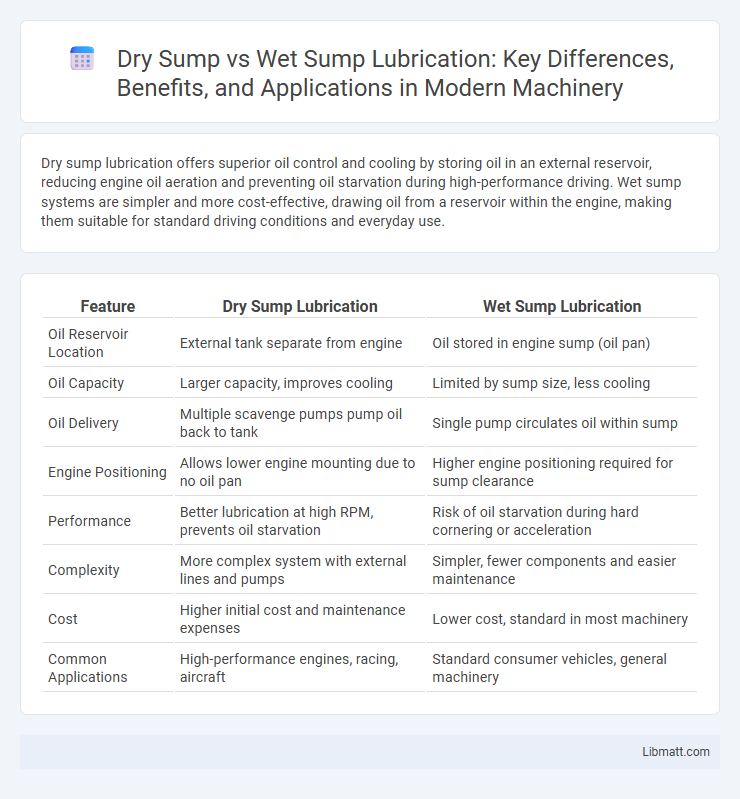Dry sump lubrication offers superior oil control and cooling by storing oil in an external reservoir, reducing engine oil aeration and preventing oil starvation during high-performance driving. Wet sump systems are simpler and more cost-effective, drawing oil from a reservoir within the engine, making them suitable for standard driving conditions and everyday use.
Table of Comparison
| Feature | Dry Sump Lubrication | Wet Sump Lubrication |
|---|---|---|
| Oil Reservoir Location | External tank separate from engine | Oil stored in engine sump (oil pan) |
| Oil Capacity | Larger capacity, improves cooling | Limited by sump size, less cooling |
| Oil Delivery | Multiple scavenge pumps pump oil back to tank | Single pump circulates oil within sump |
| Engine Positioning | Allows lower engine mounting due to no oil pan | Higher engine positioning required for sump clearance |
| Performance | Better lubrication at high RPM, prevents oil starvation | Risk of oil starvation during hard cornering or acceleration |
| Complexity | More complex system with external lines and pumps | Simpler, fewer components and easier maintenance |
| Cost | Higher initial cost and maintenance expenses | Lower cost, standard in most machinery |
| Common Applications | High-performance engines, racing, aircraft | Standard consumer vehicles, general machinery |
Introduction to Engine Lubrication Systems
Engine lubrication systems play a crucial role in maintaining optimal performance and longevity by reducing friction and dissipating heat. Dry sump systems use an external reservoir to store oil, ensuring consistent lubrication under extreme conditions and preventing oil starvation during high-speed maneuvers. In contrast, wet sump systems store oil in the engine's crankcase, offering a simpler and more cost-effective solution for everyday driving needs.
What is a Dry Sump Lubrication System?
A dry sump lubrication system uses external reservoirs and multiple scavenging pumps to circulate oil, ensuring consistent oil pressure and improved engine cooling under high-performance conditions. Unlike wet sump systems, which store oil in the engine pan, dry sump systems reduce oil starvation during extreme driving maneuvers by removing oil from the crankcase more efficiently. This design enhances engine reliability, reduces parasitic drag, and allows for lower engine positioning and improved vehicle handling.
What is a Wet Sump Lubrication System?
A wet sump lubrication system stores engine oil in a pan located at the bottom of the engine, where a pump circulates the oil to lubricate moving parts. This system is simpler, more cost-effective, and commonly found in most passenger cars due to its compact design. However, wet sumps are less efficient in high-performance or off-road engines where oil starvation during extreme conditions can occur.
Key Differences Between Dry Sump and Wet Sump
Dry sump lubrication systems use an external reservoir to store oil, ensuring consistent oil pressure and improved engine cooling, whereas wet sump systems store oil in the engine's oil pan, making them simpler and more cost-effective. Dry sump setups reduce oil aeration and provide better oil control during high-performance driving, while wet sump systems are more common in everyday vehicles due to their straightforward design. The key differences include oil storage location, complexity, and suitability for high-performance versus standard driving conditions.
Advantages of Dry Sump Lubrication
Dry sump lubrication offers superior oil control by preventing oil starvation during high-performance driving or extreme cornering, enhancing engine reliability and longevity. It provides consistent oil pressure and efficient cooling as oil is stored in an external reservoir, ensuring optimal lubrication under strenuous conditions. Your engine benefits from reduced parasitic drag and lower risk of oil aeration compared to wet sump systems, improving overall performance.
Advantages of Wet Sump Lubrication
Wet sump lubrication offers several practical advantages, including simpler design and lower manufacturing costs due to the oil being stored in the oil pan beneath the engine. This system provides consistent lubrication at low speeds and affordable maintenance, making it ideal for most everyday vehicles. Your engine benefits from reliable oil circulation without the need for complex pumps or reservoirs, enhancing overall efficiency and reducing potential leak points.
Common Applications: Dry Sump vs Wet Sump
Dry sump lubrication is commonly used in high-performance racing engines, luxury sports cars, and aircraft due to its superior oil control and heat dissipation under extreme conditions. Wet sump lubrication is typically found in standard passenger vehicles, motorcycles, and small engines where simplicity, lower cost, and ease of maintenance are priorities. Racing cars like Formula 1 and high-end motorcycles favor dry sump systems to prevent oil starvation during high-speed cornering, while daily drivers and commuter vehicles rely on wet sump systems for reliable and efficient lubrication.
Impact on Engine Performance and Reliability
Dry sump lubrication improves engine performance by maintaining consistent oil pressure and preventing oil starvation during high-speed cornering, which enhances reliability under extreme driving conditions. Wet sump systems are simpler and lighter but may suffer from oil aeration and reduced lubrication efficiency at high g-forces, potentially compromising engine durability. Optimal lubrication choice directly influences thermal regulation, friction reduction, and overall engine longevity.
Maintenance and Cost Considerations
Dry sump systems typically require more complex maintenance due to additional components like external reservoirs and scavenge pumps, leading to higher initial and upkeep costs. Wet sump systems are simpler, resulting in lower maintenance requirements and reduced overall expenses, making them more cost-effective for standard vehicle use. Choosing between the two depends on your budget and willingness to handle maintenance intricacies associated with dry sump configurations.
Choosing the Right Lubrication System for Your Engine
Selecting the right lubrication system for your engine depends on factors like engine design, performance requirements, and operating conditions. Dry sump systems offer superior oil control, preventing oil starvation during high-performance or off-road use, while wet sump systems provide simpler, more cost-effective maintenance suited for everyday driving. Evaluating your vehicle's usage and desired reliability helps determine whether a dry sump or wet sump lubrication system best meets your needs.
Dry sump vs wet sump lubrication Infographic

 libmatt.com
libmatt.com